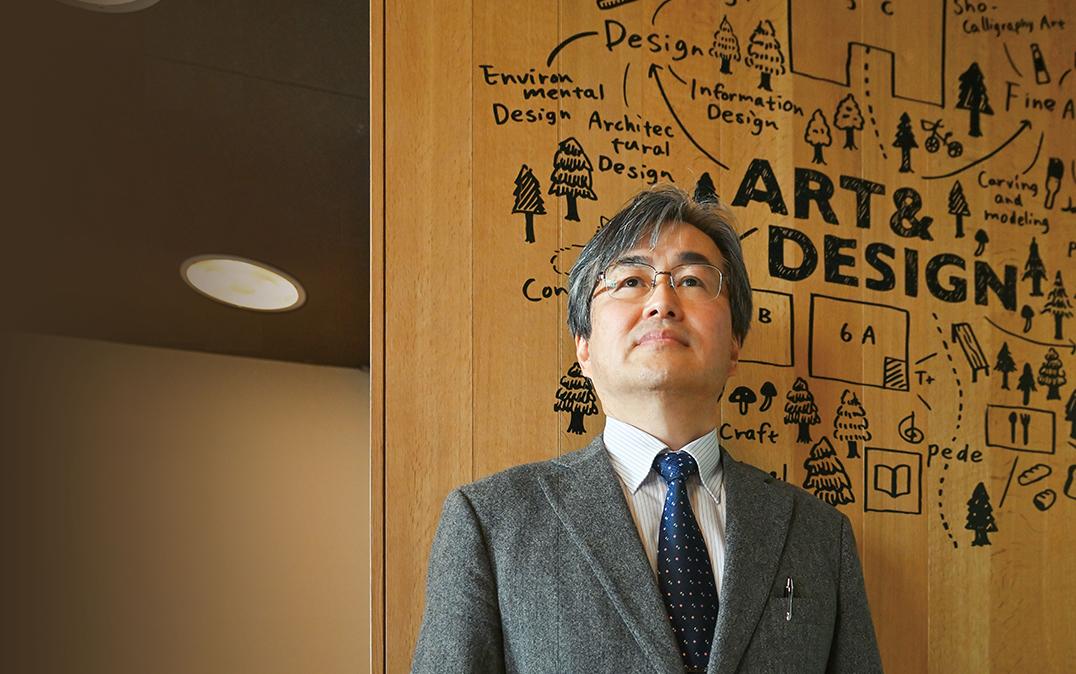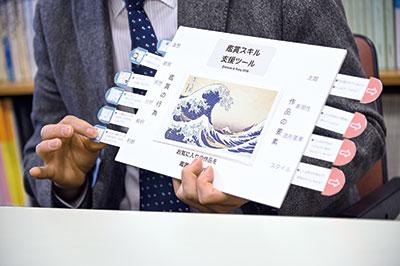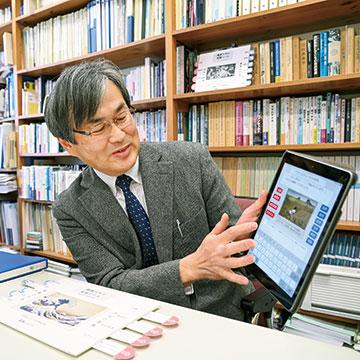TSUKUBA FRONTIER
#040 New Art Education to Verbalize One's Inner Self: Toward a Broader Art Appreciation for Understanding Diversity
Professor ISHIZAKI Kazuhiro, Institute of Art and Design

Art works are no longer to be enjoyed quietly and alone
Even if you unaware of the history or techniques by which an artwork is created, you should be able to conceptualize what you feel about it and talk about it with others.
Everyone should have their own interpretation of an artwork.
We have developed tools that anyone can use to guide them in their appreciation of art, and we propose new means of dealing with art.
Everyone has their own way of interacting with art

Arts and crafts classes and art lessons once focused on creating one's own works of art and expressing one's own individuality. How many people now, however, continue to engage in expressive activities after they finish their schooling? Instead, they are more likely to become familiar with works of art by means of museums and events. In contrast, even in reference to works that are considered masterpieces, we often find ourselves at a loss as to how to appreciate them and what to appreciate, when we stand in front of them. What is lacking is the ability to appreciate them. This can be learned in one's schooling, of course, but it is never too late to begin to appreciate art, even as an adult.
Each person experiences something different in a work of art. This can be an opportunity for the viewer to reflect on their own feelings and way of life or to try to understand those of others. Setting aside the historical background of the work and the artists' intentions, contemporary society and the viewer's own situation can change the meaning of the work. Therefore, it is natural for each viewer to have a different interpretation of an artwork, and it is important to recognize these differences.
Providing a foothold for art appreciation
Thus, there is no right way to appreciate a work of art, but even so, it is important to find a way to gain a foothold in one's own appreciation process. A variety of tools can help you take that first step. For example, without going to a museum, one can look at postcards reproducing works of art to identify the elements, colors, shapes, and so on that are depicted on the postcards. This does not require any knowledge of art that is difficult to attain. There is no need to immediately critique a given work or discuss your impressions of it. In addition, if a school teacher or other facilitator can act as a dialog facilitator, you can discover the things that you are most interested in.
The mechanism of this tool is simple and full of handmade features, but it is a better tool for drawing out language rather than simply looking at the artwork would be. Using these tools in trying different ways of viewing artworks, you will find your own favorite ways of doing so, and your repertoire of viewing options will increase. Art museums themselves have been developing similar tools and holding workshops to provide more diverse ways of enjoying art, and opportunities of acquiring art appreciation skills are growing.
Appeal of art appreciation grounded in verbalization
The key here is to verbalize. By expressing one's ideas in words rather than merely feeling a certain way, the feeling of being moved or shocked by a work of art can interact with the visual image and what one says to further deepen and deepen one's thinking. In communication with others, we can share our thoughts and feelings, and by allowing for differences, we can see new value in a work of art. This is the fascination of art appreciation. It is impossible for this to happen between the artwork and its creator alone. The viewer is an indispensable part of the art.
Verbalization is also a skill that has been emphasized in education in recent years. If art education provides training in verbalization, this will lead to the cultivation of comprehensive skills that covers each subject area. Against this backdrop, greater efforts to promote art appreciation are being made.
Toward creative art appreciation
The subject of art incorporates a wide range of creativity.
The acronym ART, standing for artist, researcher, and teacher, has been attracting attention to the tendency to move away from traditional production-centered education to one that includes a lifelong education perspective promoting educational practices from these three perspectives. Art education that focuses on art appreciation actually forms a new field of research.
Art appreciation is active, not passive. It is a creative activity and form of self-expression that allows each individual to express their own individuality, just as in the creation of artworks. Artworks in new styles are becoming more common, such as in the form of immersive exhibits, works that are combined with video images and those that allow the viewer to enter a virtual space, which requires new ideas for appreciation support tools. The world of art appreciation is being expanded with the aim of bringing more people into contact with art and enriching their lives through artworks.
Profile

Ph.D. in Art and Design from the Graduate School of Art and Design, University of Tsukuba. He was an Assistant Professor at Akita University, Visiting Scholar at Ohio State University, Associate Professor at Utsunomiya University, and Associate Professor at the University of Tsukuba before assuming his current position. "Aesthetic development in cross-cultural context: A study of art appreciation in Japan, Taiwan and the United States," Studies in Art Education, 43(4), 2002, A Study of Development and Repertoires in Learning about Art Appreciation (Kazama Shobo, 2006), "Study of Repertoires in Writing about Art," The Journal for Japanese Association of Art Education, 27, 2006 (received the "Art Education" Award), Visualizing and Deepening Thoughts in the Learning Process of Art Appreciation (Toshindo, 2022).
(URL:https://www.geijutsu.tsukuba.ac.jp/kansho-en/)
Article by Science Communicator at the Bureau of Public Relations
TSUKUBA FRONTIER (PDF for printing)


